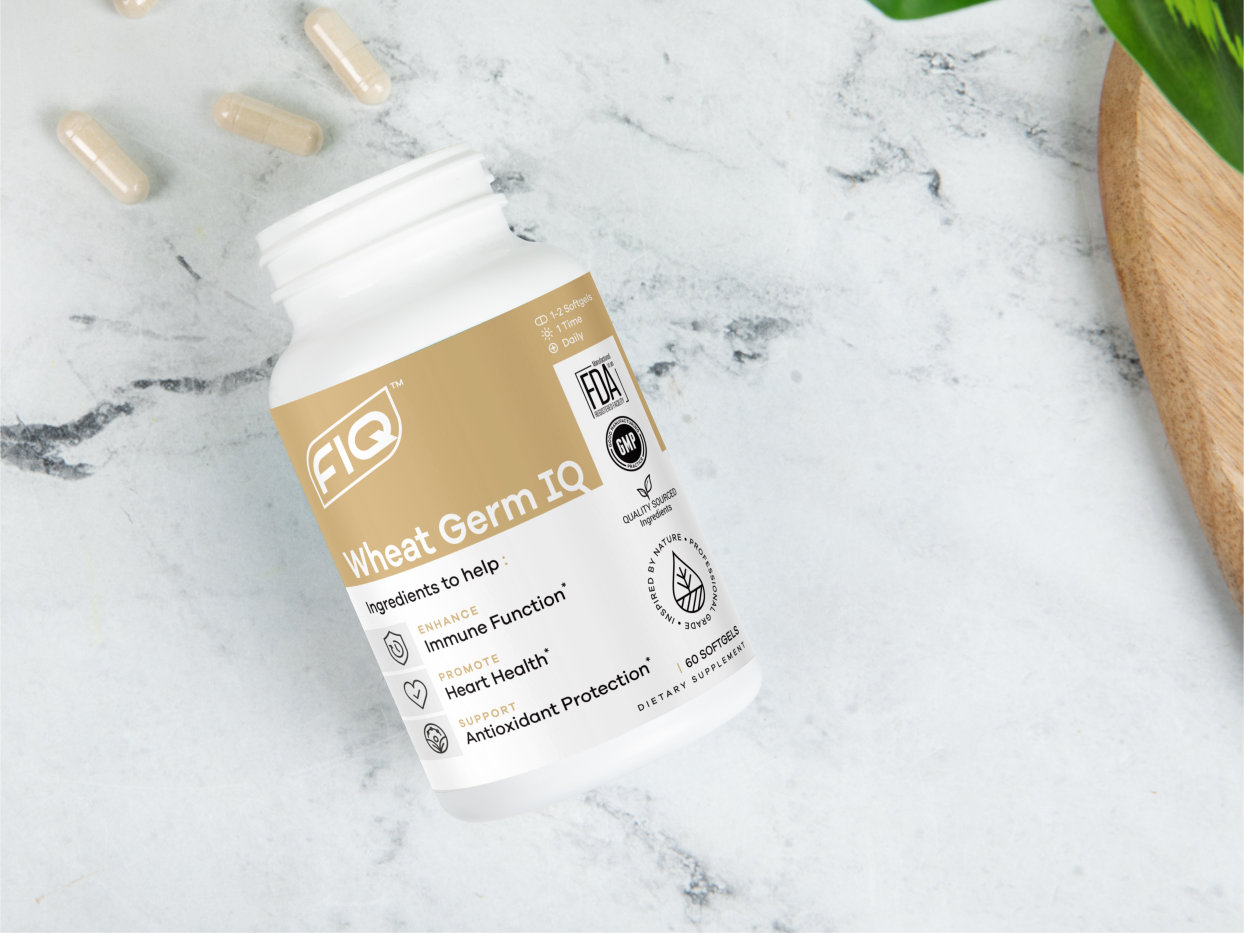Wheat Germ – The Unlikely Superfood

Wheat germ is most commonly thought of as a whole-food source of vitamin E. While it is one of the most concentrated natural sources of vitamin E, it also offers several other therapeutic molecules, including B vitamins, healthy plant sterols, unsaturated fatty acids, and phytonutrients like:1
- Policosanols
- Phytosterols
- Carotenoids
- Flavonoids
- octacosanols
- Steryl ferulates
With such a rich content of vitamin E, healthy fats, and phytonutrients, wheat germ oil offers numerous health benefits.
Health benefits of Wheat Germ
Anti-inflammatory
Wheat germ contains pentadecanoic acid, hexadecenoic acid, linoleic acid, and cyclohexanol, which have been shown to have anti-inflammatory effects across various pathways within the body.2 A single extracted constituent of wheat germ oil reduced inflammatory cytokines NO, IL-6, IL1B, and TNF-a while stimulating the production of collagen, new tissue cells, and IL-10 (an anti-inflammatory molecule) in skin wounds of mice.3
Wheat germ oil decreased TNF-a and IL-6 production in human immune cells called monocytes.4 These immune cells and the inflammatory cytokines they produce are strongly associated with cardiovascular and other inflammatory diseases. Thus supporting the role of wheat germ oil’s cardioprotective effects. 4
In mice fed a high-fructose diet, wheat germ reduced inflammatory cytokines and improved the Treg:Th17 immune cell ratios compared to those who were not fed wheat germ.5 Imbalances to this particular ratio of immune cells are correlated with various autoimmune diseases.6
Gut Health
In the same mice study mentioned above, the addition of wheat germ also increased the beneficial species of probiotic bacteria, lactobacilleae 4 times that of the control group.5 It was also found to be protective against parasitic infections with C. parvum bacteria in another study.7
Liver Health</h3
In people with non-alcoholic fatty liver disease, wheat germ oil improved several markers of liver health by reducing ALT, GGT, and CRP. They also had decreases
in total cholesterol and triglycerides and increased total antioxidant capacity compared to those who did not receive wheat germ oil.8
Wheat germ oil also improved liver damage caused by alcohol in a rat study, indicating that it may also be helpful for fatty liver disease related to alcohol intake.9 The method by which wheat germ protects the liver appears to be due to its protection against lipid peroxidation in liver cells.10
Wheat germ oil also protects the liver against oxidative damage caused by pesticide intoxication in mice.11 This liver-protective role is promising, considering the amount of pesticides used in our modern food and environment,
Reduces Cholesterol
Researchers have also observed cholesterol-lowering effects of wheat germ oil.12 This, along with its protection against lipid peroxidation, offers a convincing rationale for wheat germ oil as a natural cardioprotective compound.12
In addition to the numerous phytonutrients and healthy fats in wheat germ oil, several of the protective mechanisms stem from the potent antioxidant capacity of vitamin E.
Role of Vitamin E in Health
Vitamin E is found primarily in plant foods, with wheat germ oil being the richest source. One tablespoon of wheat germ oil contains 20.3mg of vitamin each, more than the RDA of 15mg.13
There are 8 different types of vitamin E molecules (called vitamers). While some research suggests that the alpha-tocopherol form is the most biologically active in humans,13 many studies have found greater antioxidant activity from mixed tocopherols.14
The most important and primary role of vitamin E in the body is its function as an antioxidant, particularly in cellular membranes. The membranes of cells and their organelles consist of various fat molecules, both saturated and unsaturated.
Unsaturated fats are easily subjected to damage (aka oxidation) from free radicals, which are constantly being produced by various metabolic processes. Vitamin E protects the unsaturated fatty acids in cellular membranes from oxidation – thus preserving the health and functionality of the cell.13
Vitamin E is also an essential molecule involved in a process called signal transduction, wherein it binds to a particular molecule to change its configuration. Thus initiating a specific cellular or metabolic action.13 In other words, vitamin E turns on or off specific cellular functions.
Vitamin E is also involved in gene expression of various essential proteins, including the production of the estrogen receptor-beta.13 This estrogen receptor has been shown to counterbalance the negative health impacts of the estrogen receptor-alpha.15 Lastly, vitamin E has been shown to improve immune system function16 due to its cellular antioxidant activity, signal transduction, and gene-expression properties.
Does Wheat Germ Contain Gluten?
The germ of the wheat makes up only 2-3% of the total weight of the wheat grain. The germ is the outer portion that surrounds the bran and endosperm. The germ itself is also called the embryo, as it supplies the nutrients to the rest of the grain during development.1
The endosperm is the portion that we are most familiar with regarding wheat food products. It’s the starchy portion that contains gluten, hence its preference in baking, as gluten helps to bind constituents together.
If you consume whole wheat products, the bran is included along with the endosperm, but not the germ, as it spoils quickly. The bran of wheat has more fiber, B vitamins, and protein than the endosperm. This is why whole wheat is more beneficial than processed or stripped wheat.
The germ portion of the plant does not contain gluten proteins. Gluten is present only in the bran and endosperm. However, because of the high risk of cross-contamination during processing, individuals with celiac disease should avoid wheat germ oil.
Most individuals with non-celiac gluten sensitivity find that they tolerate wheat germ oil well, but this is highly individualized. You should always consult your doctor before adding it to your diet or supplement regimen.
Citations:
12. Gropper, S., Smith, J., & Carr, T. (2018). Advanced nutrition and human metabolism (7th ed.). Cengage Learning.

